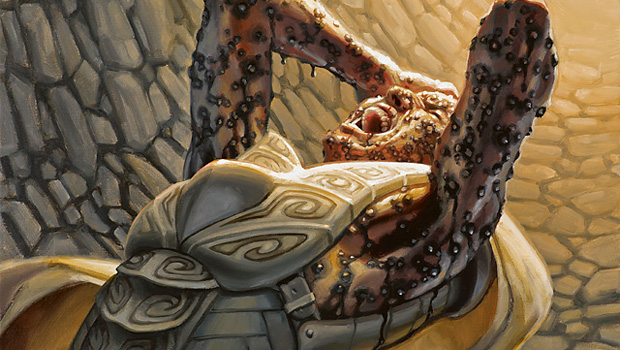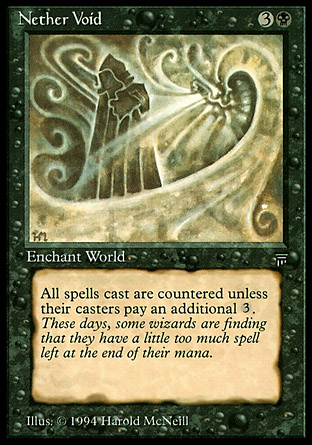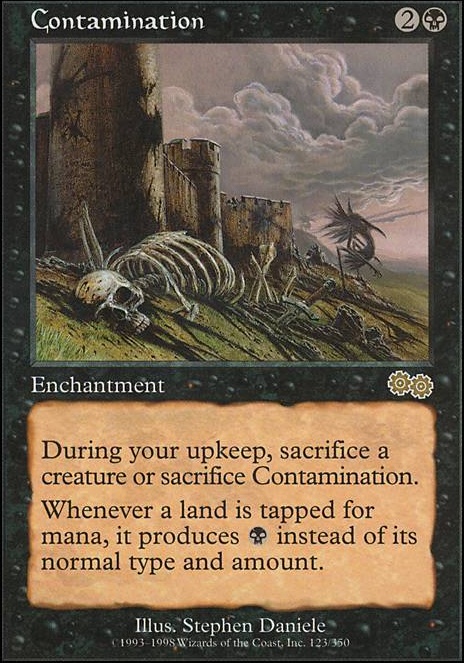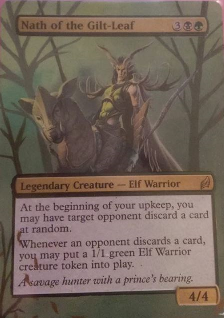Introduction
My favorite deck: Nath of the Gilt-Leaf Stax. Created to play against fast combo decks, as such it is built on a curve and with a need to apply the best board wide disruption as quickly as you can.
Deck History.
This Deck is technically my second EDH deck, however very few cards if any remain from the original list. The original build spawned when I picked up a copy of Smokestack. With much enthusiasm I began to draft up a list, running for cards such as Call to the Grave and Braids, Cabal Minion. was the second color chosen for my at the time fascination with Talrand, Sky Summoner and the inclusion of Mana Vortex and counter magic. the final color was brought in for Cards like Armageddon and Enlightened Tutor. Given how I viewed stax, Sen Triplets became the commander. Now while the shell and even commander would all make a perfectly fine deck, I wanted something more destructive and streamlined. The triplets were good, but contributed nothing to the plan of locking down the board. I saw Thraximundar after the deck sat shelved for a while, and a new list was drafted. Thraximundar seemed at the time to be the best option *on paper*. In theory he would close the game once Call to the Grave effects were in place, this was not the case when I played it. Thraximundar was far too costly for what I wanted from a deck that *limits resources*. Again the deck was shelved for a few months while I thought of something to crank my Smokestack to eleven.
This is where I came to my favorite colors, . This is where most of the deck you'll see now was developed. The *potent and under-costed* ramp provided by allowed the deck to jump into games with an early Stax effect. With Green Mana in the picture, Powerful token producers now were in great supply and paired with Black mana, I had diverse removal at my disposal. Glissa, the Traitor Had been chosen as my commander, to recur my litany of stax effects and small artifacts that gave advantage overtime.
This deck was *solid* and put up a great front, however for the third time, the commander wasn't helping the strategy. After a while playing the deck Glissa's lack of direct synergy became very relevant, so a quick Gatherer search brought me to Nath of the Gilt-Leaf.
Why play Stax?
Stax as an Archetype is one where you limit your opponents resources, and ultimately create a board-state where your opponents can't cast spells. This strategy is characterized by land destruction, taxing and tapping effects, and an environment where slow consistent advantage is important. These types of decks don't Let your inner Timmy run wild with large things, nor your Johnny chain multiple spells, you aren't doing many flashy things.
Because of the nature of this playstyle, misplays are much more painful for you. Greedy plays like playing a Kodama's Reach turn 2 off your first turn Birds of Paradise may seem great, you have 5 mana turn 3. But then when your opponents are dropping Sol Rings and exploding out of the gate, you may not recover because you didn't play that turn two Null Rod. If you like forgiving decks, that don't get set back far by misplays this deck may not be your cup of tea.
Since this is an EDH deck, considering your playgroup is something to keep in mind when building a stax deck. Often newer players, and playgroups on a low powerlevel won't take well to having a Pox take out Avacyn, Angel of Hope and all those plains, keeping her off the board.

However if your playgroup consists of mature players who accept there's more ways to play EDH than just ramp-fatties-swing, stax is a great way to play.
If you look back at the Deck history, Nath of the Gilt-Leaf was what I wanted all along, his cmc of meant I could drop him after a stax effect and be stabilized, thanks to having his unique combination of abilities:
"At the beginning of your upkeep, you may have target opponent discard a card at random.
Whenever an opponent discards a card, you may put a 1/1 green Elf Warrior creature token onto the battlefield."
On paper, Nath is a Bitterblossom for a staggering 5 mana. However if you are assuming there's much more to Nath's strength, you are correct Tappedout user!
On your upkeep Nath of the Gilt-Leaf allows you to target an opponent, and force them to discard at random. This is deceptively strong, often removing that 1 land your foe was looking for to cast their commander and pull ahead, or a removal spell for our stax piece. We can strip cards at the whim of chance, not our opponent's choice. This prevents them from discarding potentially irrelevant cards and breaking away from your lock.

His second ability is what is most impressive. Nath creates 1/1 Elf-warrior tokens when ever an opponent would discard a card, period. That combo player went off with Greater Good, and didn't manage to alpha strike? You get elves. We can take advantage of this by using powerful discard effects, such as Liliana of the Veil or Bottomless Pit. Now not only are we stripping permanents off the table, but the ones being sandbagged, to break our lock are being taken as well.
Decklist Break-down.
The last topic in this section is reading the list I created.
The Stax section is the Meat and potatoes of the deck, our core plan is to use these cards to lock down our opponent.
The Ramp section is next, and if you notice all the cards apart from one are cmc of or , this is to ensure you hit 4 mana as quick as possible and then play your Stax effects.
Fodder and Discard. I'm grouping these together due to the fact that our commander makes them almost one in the same. They allow us to produce permanents, typically tokens to offer to our own effects.
Tutors and Draw are also lumped together due to them offering more ways to get our stax and fodder effects.
Removal section is for spot removal and board wipes. Sometimes we need a Gaddock Teeg off the table, or take away an opponents Jhoira of the Ghitu or Sylvan Library.
The utility section is for cards, like Yawgmoth's Will that recur cards we want, Null Rod who isn't a true stax effect but lacks a solid section, or Scavenging Ooze and Trading Post cards that preform multiple tasks for us.
The last sections are the Sideboard which consists of cards that Are used in 1 on 1 matches, namely the Discard spells, meta calls such as Leyline of the Void in a graveyard heavy meta, or Defense Grid and Mana Web for heavy metas, and the Maybe board which is cards currently being tested or I'm looking into.
A Guide to destroying literally everything:
How to Play the Deck.
Let's start right of the bat, you drew 7 cards, what hands do you keep?
Keep-able hands are usually 2-3 lands, a stax piece, ramp and the remainder being cards to continue our lock(more stax pieces) or get more stax pieces(our draw spells and tutors).

A more specific example of a solid opening hand would be something like: Swamp, Bloodstained Mire, Demonic Tutor, Sensei's Divining Top, Arbor Elf, Smallpox and Abrupt Decay. While you could mulligan away the Abrupt Decay, you may notice a GW (Selesnya) player across from you. Decay saves you from a Gaddock Teeg or Aura Shards, now you have a great answer to these cards. The hand has the ability to curve out with a turn 1 Bloodstained Mire for Bayou into Arbor Elf. On turn 2, cast Demonic Tutor for a relevant stax piece and land Sensei's Divining Top to dig for even more cards to build your prison.
Do you want Stax? Because this is how you get them!
Let's expand on that example hand, and explain it and how the deck wants to function in the early game. T1 you are almost always looking to ramp, be it a mana dork such as Deathrite Shaman or Green Sun's Zenith. I brought up reading the table and seeing what other players are playing to determine what to mulligan, and the early game is the biggest reason for this. If you notice an Arcum Dagsson, Nahiri, the Lithomancer and Rafiq of the Many all across from you. keeping a hand with a Forest, Exploration and Null Rod is VERY strong. You can drop and ramp unaffected nulrod, turning off the equipment of 2/3s of the table and the ramp of the other. This won't win the game, but we're pushed ahead. Our deck is mostly non artifact ramp, and our key artifacts have triggered abilities and or static ones. Other strong cards in the Early game are Lodestone Golem, Sphere of Resistance, Thorn of Amethyst and Tangle Wire. these cards keep our opponents off tempo for a few critical turns while we more often then not, can cast ramp spells to get to the critical midgame.
Mid game plan.
Going back to our example hand, lets start at the begining of turn 4. We've drawn a Dark Ritual, Verdant Catacombs and Windswept Heath over the following turns, playing the Windswept Heath for a Forest turn 3. The board is Bayou,Swamp, Forest, Sensei's Divining Top, Arbor Elf and Smokestack. our turn begins, we untap and go to upkeep.
This is where the triggered abilities of Smokestack go into effect. Both go on the stack at the same time, and as the controller of Smokestack we decide what the order they resolve in is. This principal applies too ALL stax effects. if we have The Abyss and Call to the Grave out, we can stack our triggers so our opponent with 2 creatures, one a zombie one not, are both sacrificed! But more importantly, we use this ruling to always stay ahead on tempo with our sacrificing.
You want the abilities to resolve in a manner so you sacrifice before you add counters. To do this we put the abilities that allows us to add counters on the stack first, then we have the sacrifice trigger go on the stack. By doing so the stack will resolve, we sac no permanents and then may add a counter.
We activate top after our Smokestack abilities and see Elvish Mystic Merciless Executioner and Exploration, and choose to put Elvish Mystic on top to draw it, we move to our main phase. We play and crack the Verdant Catacombs, play Nath. Over the rest of the Game, we will crank up Smokestack, strip down the lands and cards if our opponents. We stay ahead on resources with our discard and other fodder producers.
Putting them out of their misery.(Late game)

After we have a board state as descibed above, our mindset is keeping them down, taxing effects like Nether Void turn the soft lock where opponents sacrifice their land on upkeep, and play one on their turn into a hard lock, where they can't cast spells through our effects. If we only manage to break down a few lands then lose our stax effect, we have the option to grab Death Cloud or Pox and nuke our opponent's last permanents.But regardless of how we get there, by now we should have a lock on the table, and Nath of the Gilt-Leaf and his battalion of elves are at work chipping at our foe's life.
Budget cuts (Cash Rules Everything Around Me)

A Majority of the expense of this deck comes from the fetch lands, ABUR Dual, Wasteland and the Legends cards (The Abyss and Nether Void). cutting these, while hurting deck function, is a great way to construct the deck similarly. Liliana of the Veil is another choice to cut for something such as Cunning Lethemancer
Wrap up and Thanks.
A thanks in advance for any suggestions or upvotes! A thanks to ibanner56, Weirdhat and hippienproud. I play with these three regularly and they've helped sculpt (and tolerate) this deck's power. Their decks are:
Weenie Hut Jr by ibanner56
Hurricane Nekusar by Weirdhat
nothing beats wandering with friends by hippienproud
Thank you to
Epochalyptik for his code in the Primer Primer.
2024 Update!
I hadn't checked this primer in a few years, my apologies it looks like the buttons no longer worked, I tried my best to quickly clean the primer up.
Thank you to Coinman1863 for bringing this deck's concept to CEDH: Combo? Where We're Going, We Don't Need Combo
Additionally I'd like to plug the
Nath cEDH Discord
I'm glad that Nath stax has gone as far as it has :)

































